
As a fierce optimist, I don’t readily use a negative frame to examine a case. Sure, I sometimes pull out an “inverted brainstorm” (where you wonder what’s wrong) and ask the question at the beginning of a project, “what happens if we don’t do this project?”, but that’s about it. Still, I know that sometimes a negative frame can be enormously purifying. Great examples are the “fuck-up nights” or the “museum of failure. Some scientists can turn a negative frame into a “unique selling point,” such as design scientist Jasper van Kuijk. Since a negative frame ultimately brings an awful lot and is therefore essentially very positive, I decided to immerse myself in his work.
Evil mother-in-law
“It is often much clearer what could have been better about a failed product than what is good about a successful one,” Van Kuijk writes in his book “How Hard Can It Be?” (2016, p. 8). Yet we are all incredibly diligent about focusing on that successful product. We want to understand it, we want to learn from it, AND we want to create it. When we lecture or explain a point of view, we all use Apple as an example, under the guise of “learn from the best. After reading Van Kuijk’s work, I have the idea that in the search for the most successful product, perfectionism acts as the evil mother-in-law: that which tries very hard to “please” you, while, deep down, you know that this takes you further away from your own core. Consequently, Van Kuijk wipes the floor with perfectionism: ‘Perfectionism has no sense of humor‘ (Van Kuijk, 2016, p. 11), or ‘Perfect is the enemy of done‘ (Van Kuijk, 2016, p. 57). The message is clear: we want to be perfectionists and strive for ultimate success but don’t get anywhere with it in practice.
The imperfect
As I began to specialize more and more in design thinking, I realized that I didn’t need to be able to do more things, but more importantly, I needed to cut back on perfectionism. Designers are good at designing, but they are especially good at making a thousand and one different sketches, of which a thousand end up in the trash, and only one remains. The talent to throw self-made work into the trash is given only to a few. Therefore, I subjected myself to personal training in perfectiominating. I took drawing lessons with a wonderful drawing teacher who forced me to start over and over again. Instead of making my work better, I started playing a new instrument that I knew I would never be able to master it perfectly (the balafon), I started making a 10-minute sketch every day, and I forced myself in projects not to work through to a final result but to share the intermediate, imperfect, state of affairs. I learned that in design processes, it is precisely the sharing of unfinished work that lowers the threshold for others to express their ideas on that work and that through feedback from others, the work ended up being much better. Funnily enough, then, perfectiominating gave an end result that was ultimately closer to perfectionism.
Perfectiominating
Now that I train others in design thinking, I especially train them in perfectiominating. One of the fastest and most effective ways to do that is time-framing: 60 associations in 5 minutes, 8 prototypes in 8 minutes, and one proposal supported by everyone in 10 minutes. Because of time constraints, you have to move on and don’t have time to get bogged down in details. I could always give everyone more time for each assignment, but I deliberately don’t. After all, extra time does not make an idea better; it only makes the idea more perfectly worked out. And the more perfectly worked out the idea is, the less likely it is to end up in the trash. An idea actually gets better by incorporating the perspectives of others. You get those perspectives from others faster if the idea is not perfectly worked out; then people are challenged to think with you. It is not that perfectionism, but precisely that challenge that belongs under the magnifying glass.
It has to be a little difficult
Designs get better when you know how to challenge yourself all the time. Always wanting to learn, try new things, and explore. We don’t have to master things perfectly, just not perfectly. Things should be just a little bit difficult. ‘Things are often fun precisely not because they are easy, but because they are difficult,’ notes Jasper van Kuijk in his column for the Volkskrant (2022). He is absolutely right!

